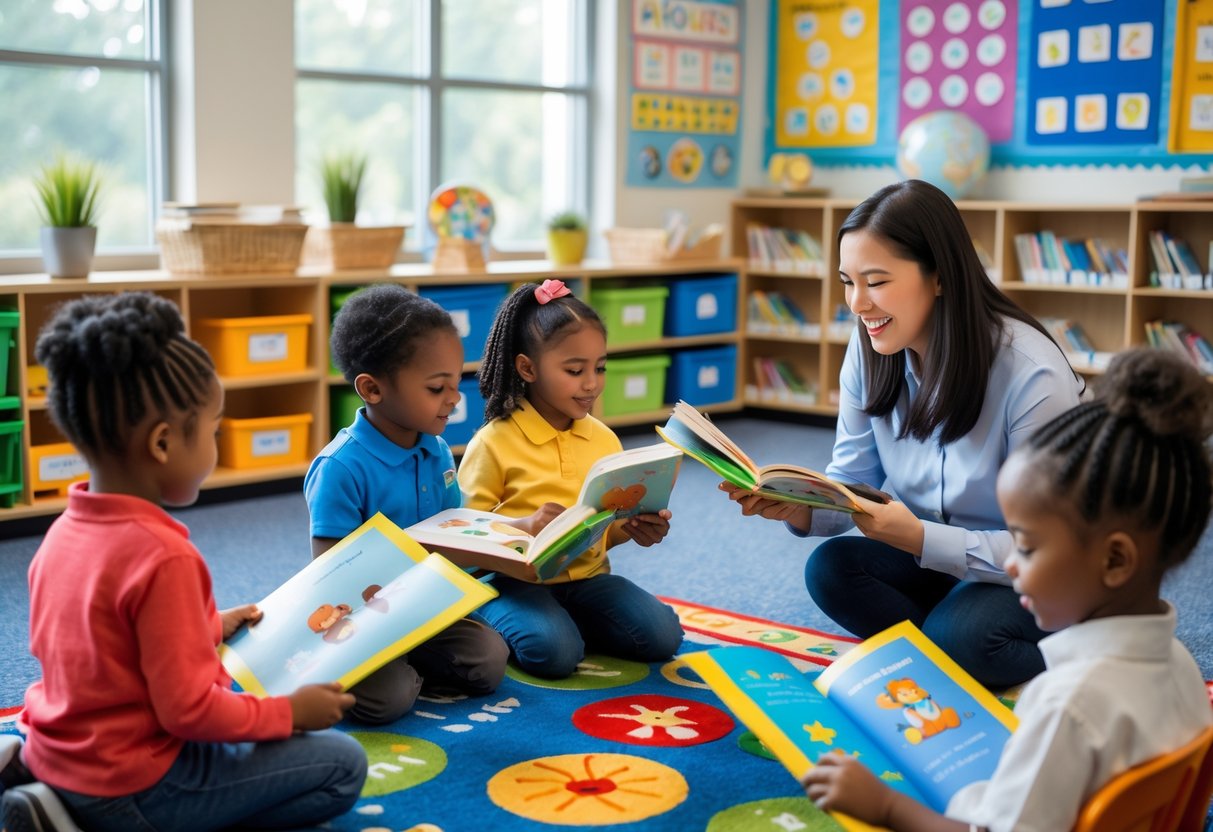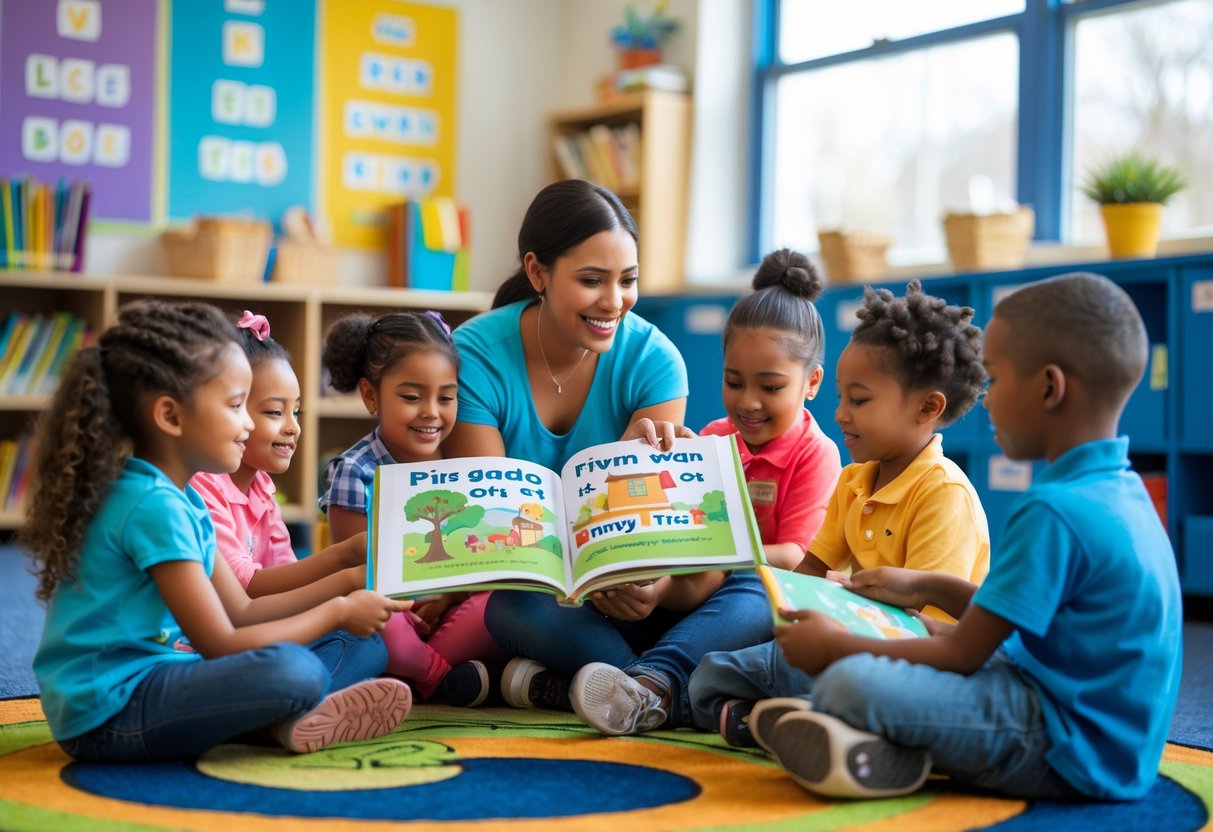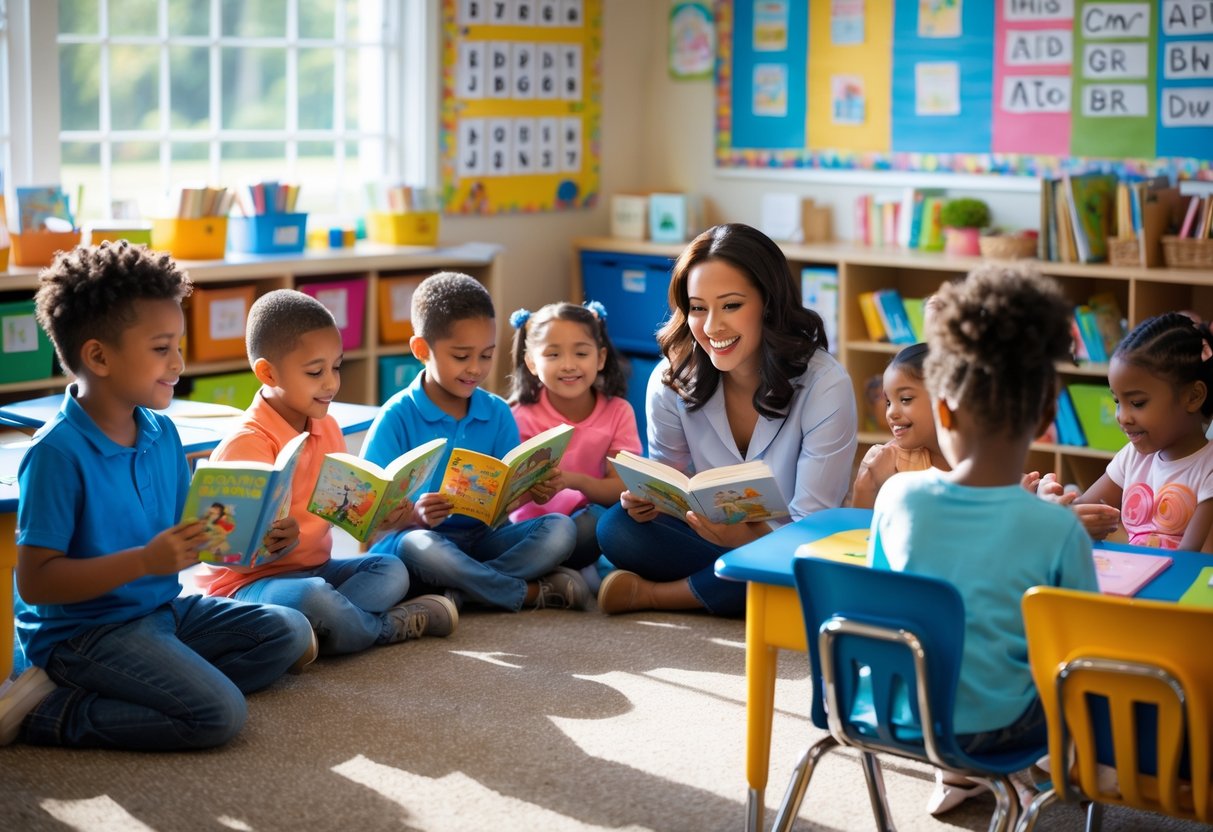A first grade reading level means your child can read simple words, short sentences, and easy books. At this stage, kids start to sound out words and understand what they read.
You may wonder how schools know if your child is reading at a 1st grade level or how you can support their progress. This guide explains what you need to look for and how to help your child feel confident with reading.
Key Takeaways
- First grade reading level focuses on simple words and sentences
- There are clear ways to check reading progress
- Supporting at home helps kids become better readers
Understanding First Grade Reading Level
At a first grade reading level, you learn to read basic words, short sentences, and simple stories. These skills form the base for your reading journey and help you practice new words and grammar.
What Defines First Grade Reading Ability
A first grader’s ability to read means being able to read and understand simple words and sentences. You start by reading familiar words and using phonics skills to sound out new ones. Most books use short sentences with common sight words like “the,” “and,” or “is.”
At this level, you begin to use pictures to help you guess words you do not know. You also start to read with more confidence. You move from reading aloud to reading quietly sometimes. Comprehension is important, so you learn to answer questions about what you read.
Your reading skills at this stage grow quickly. You may recognize and understand basic punctuation such as periods, question marks, and exclamation points. Sight word lists and simple stories support your reading growth.
Common Milestones and Expectations
There are common milestones for first-grade readers. You often know at least 100 sight words by the end of the year. These are high-frequency words that you see all the time.
You are expected to read and understand simple sentences and short paragraphs. You start to retell stories in your own words. This helps you show that you understood the story.
Your teacher may use small books or “readers” with simple vocabulary and lots of pictures. Some skills you develop:
- Recognizing rhyming words
- Reading with some fluency
- Answering basic questions (who, what, where)
- Guessing words using context clues
These skills set you up for more complex reading later.
Simple Sentences and Story Structures
First-grade reading often uses simple sentences. Sentences are short, clear, and usually contain a subject and a verb. For example: “The dog runs.” Sentences often repeat patterns to help you learn.
Stories at this level have basic structures. They include a beginning, middle, and end. Events happen in order, making it easier for you to follow along.
Table: Story Elements
| Part | What You Learn | Example |
|---|---|---|
| Beginning | Introduces characters | “Anna has a cat.” |
| Middle | Shows an event or action | “The cat runs away.” |
| End | Resolves the story | “Anna finds her cat.” |
Simple stories use easy words and lots of repetition. This helps you practice reading and understand how stories work. You become comfortable with basics before moving on to harder books.
Methods for Assessing First Grade Reading Level

There are several tools used in schools to measure first grade reading levels. Each method uses a different way to check your child’s understanding, accuracy, and reading skills.
Guided Reading Levels Explained
Guided Reading Levels, often called GRL, place books and readers in different groups based on difficulty. Teachers assess how well your child reads a specific book and watch for word recognition, fluency, and comprehension. The most common GRL system uses letters from A to Z, with A being easiest and Z being hardest.
For first graders, you often see levels around C through J. Your child’s teacher will choose books that match the current level, then gradually move to harder books as skills improve. This helps make reading challenging, but not too hard.
Using guided reading levels helps teachers give support where your child needs it most. The main goal is to help your child gain confidence and read more complex books over time.
Lexile Framework and Lexile Measurement
The Lexile Framework for Reading matches your child with texts at the right challenge level. It gives both books and readers a Lexile score based on reading ability and text complexity. Lexile scores are numbers, usually from BR (beginning reader) up to above 1200L for advanced readers. First graders often have Lexile measures from BR to 400L.
Here’s a simple table showing typical first grade Lexile ranges:
| Grade | Typical Lexile Range |
|---|---|
| First Grade | BR-400L |
Teachers, parents, and librarians use Lexile scores to find books that are not too easy or too hard. Your child’s Lexile measure may come from a reading test or classroom assessment.
Developmental Reading Assessment
Developmental Reading Assessment, or DRA, looks closely at your child’s reading skills. The DRA is given one-on-one. Your child reads a book aloud and answers questions about it. The teacher reviews how your child reads words, understands what is connection between the text means, and retells the story.
DRA levels are numbers, starting at 1 for brand-new readers and going up as skills improve. First grade readers often have DRA levels between 3 and 16. The DRA helps teachers see exactly where your child might need help—for example, with sounding out words or understanding main ideas.
Teachers use DRA results to set goals and pick books that match your child’s reading skills.
Accelerated Reader and ATOS
Accelerated Reader (AR) is a popular program that uses quizzes to measure reading progress. After your child reads a book, they take a short quiz on the computer. Each book is assigned an ATOS level. The ATOS scale starts at about 0.5 for simple books and can go above 12.0 for high school books.
In first grade, books are usually in the 0.5 to 2.0 ATOS range. AR points are given based on the book’s length and difficulty, and your child can earn points by passing quizzes. Teachers use this information to encourage more reading and help students find just-right books.
Both the ATOS and AR systems aim to motivate your child to read and to help you know which books fit their reading level systems.
Key Components of First Grade Reading Proficiency

First grade reading focuses on developing basic reading skills that help you read words, understand stories, and use pictures to support your learning. These skills include sounding out words, reading with a steady speed, making sense of sentences, and using illustrations to get more meaning from the text.
Phonics and Decoding Skills
Phonics teaches you the way letters and letter groups stand for sounds. When you learn phonics, you understand that words can be broken into smaller parts, like cat becoming /c/ /a/ /t/. This helps you sound out words on your own.
Decoding skills let you use your phonics knowledge to read new words. If you see an unfamiliar word, you can decode it by sounding out each letter or group of letters.
Common phonics skills in first grade include:
- Recognizing simple letter sounds (b, t, s)
- Blending sounds (sl- in slide)
- Noticing short and long vowel sounds
You use these skills often, especially when reading simple books or practicing with word lists in class. Strong decoding helps you read without stopping too much.
Reading Fluency and Accuracy
Reading fluency refers to the ability to read aloud smoothly and at the appropriate speed. You don’t have to stop for each word or sound choppy. You also use a clear voice and try to follow the punctuation, like commas and periods, as you read sentences.
Reading accuracy is about saying each word correctly as it is written. You should try to read most words correctly without making lots of mistakes or guessing.
To practice fluency and accuracy, you may:
- Reread favorite stories
- Use short poems or simple readers
- Take turns reading out loud with someone
These activities help you gain confidence and make reading feel easier. Fluency lets you pay more attention to what a story is about instead of just figuring out the words.
Building Reading Comprehension
Reading comprehension means you understand what the text is saying. It is more than just reading the words; you think about what they mean. In first grade, you answer simple questions about stories and talk about what happened.
Some key skills you learn for comprehension include:
- Retelling what you read in your own words
- Naming the main idea of a book or a page
- Identifying key details, like who, what, when, where, why, and how
You can use tools like story maps or lists to help you remember details. Sometimes, teachers may ask you to draw a picture of the story, which also helps you show what you understood.
The Role of Illustrations in Understanding
Illustrations are pictures that go with the text. They develop the importance of reading for first-grade readers because they help you figure out what is happening or what certain words mean.
You may use these pictures to:
- Guess what a new word means based on the picture
- See how a character feels by looking at their face in the drawing
- Follow the order of events if you get confused by the words
Illustrations give extra clues when you are stuck or need help following the story. Some books for first graders have pictures on every page, making it easier for you to stay interested and comprehend the story better.
If you have trouble with a word, it’s helpful to look at the picture for hints. This can help you keep going without getting too frustrated.
Supporting and Enhancing First Grade Reading

Supporting first grade reading takes practice through carefully chosen activities, helpful environments, and routine checks on progress. It is important to make reading enjoyable while giving your child the help they need at their reading level.
Engaging Reading Activities for Growth
Hands-on reading activities keep first graders interested and let them practice new skills. You can use short, simple stories that match your child’s reading level. Pair these with picture books so your child can use images to understand words.
Try having your child read out loud each day. This helps boost their fluency and confidence. You can make a chart and track daily reading to show progress.
Other helpful activities:
- Play word games like matching or rhyming
- Listen to audiobooks together and talk about the story
- Let your child act out favorite scenes from books
Mixing fun activities makes it easier for children to learn new words and enjoy books.
Creating a Positive Reading Environment
A good reading environment helps your child want to read more often. Find a quiet, well-lit spot at home for reading time. Keep a small shelf or box of books that are just right for your child’s reading skills.
Let your child choose their own books from the selection. Children are more motivated to read books they are interested in. Sit together and take turns reading to make the experience bonding and supportive.
Remove distractions like the TV during reading time. Display your child’s reading chart or favorite book covers on the wall to encourage pride in their reading journey.
Tracking Progress Along the Reading Journey
It is important to know how your child is growing as a reader. Keep a simple reading log or checklist. Write down story titles and the date each one is read.
You can meet with your child’s teacher to discuss strengths and where more help is needed. Many schools use reading level charts to check improvement. Look at how your child handles new words, follows along, and answers simple questions about the story.
If your child is struggling, ask the teacher for extra reading activities or resources. Celebrate new skills learned, even small ones, to show your child their progress is important.
Frequently Asked Questions

First-grade students benefit from books, activities, and worksheets that match their early reading skills. You can use different resources and strategies to help your child become a stronger reader.
What are some recommended books for first-grade reading levels?
Some good choices for first graders include “Henry and Mudge” by Cynthia Rylant and “Frog and Toad Are Friends” by Arnold Lobel. Other options are “Pete the Cat: Rocking in My School Shoes” by James Dean and “The Snowy Day” by Ezra Jack Keats.
How can I assess my child’s reading level in first grade?
You can listen to your child read out loud and notice if they can read most words easily. Try using leveled reading lists or quick online assessments from trusted education sites. Teachers often use tools like running records or leveled passages to measure a child’s reading skills.
What type of worksheets are effective for improving reading skills in first graders?
Worksheets with short stories and simple questions help build comprehension. Activities focusing on letter sounds, sight words, and matching pictures to words are also helpful. Look for worksheets that ask children to fill in missing words or sort words by sound.
How does the reading level expectation progress throughout the first grade?
At the start of first grade, most children read short, simple sentences with basic vocabulary. By the end of the year, they can usually read longer sentences and stories with more complex words. Their fluency and understanding of the text usually grow as the school year progresses.
Where can I find free reading materials suitable for first graders?
You can find free books and stories for first graders on websites like Storyline Online or Unite for Literacy. Local public libraries often have digital collections with books at different reading levels for children.
What examples illustrate texts that are appropriate for first-grade reading abilities?
A simple book like “Go, Dog. Go!” by P.D. Eastman uses easy words and short sentences. Early readers such as “Green Eggs and Ham” by Dr. Seuss or “Little Bear” by Else Holmelund Minarik are also examples. These books have lots of repetition and pictures to support the words.

